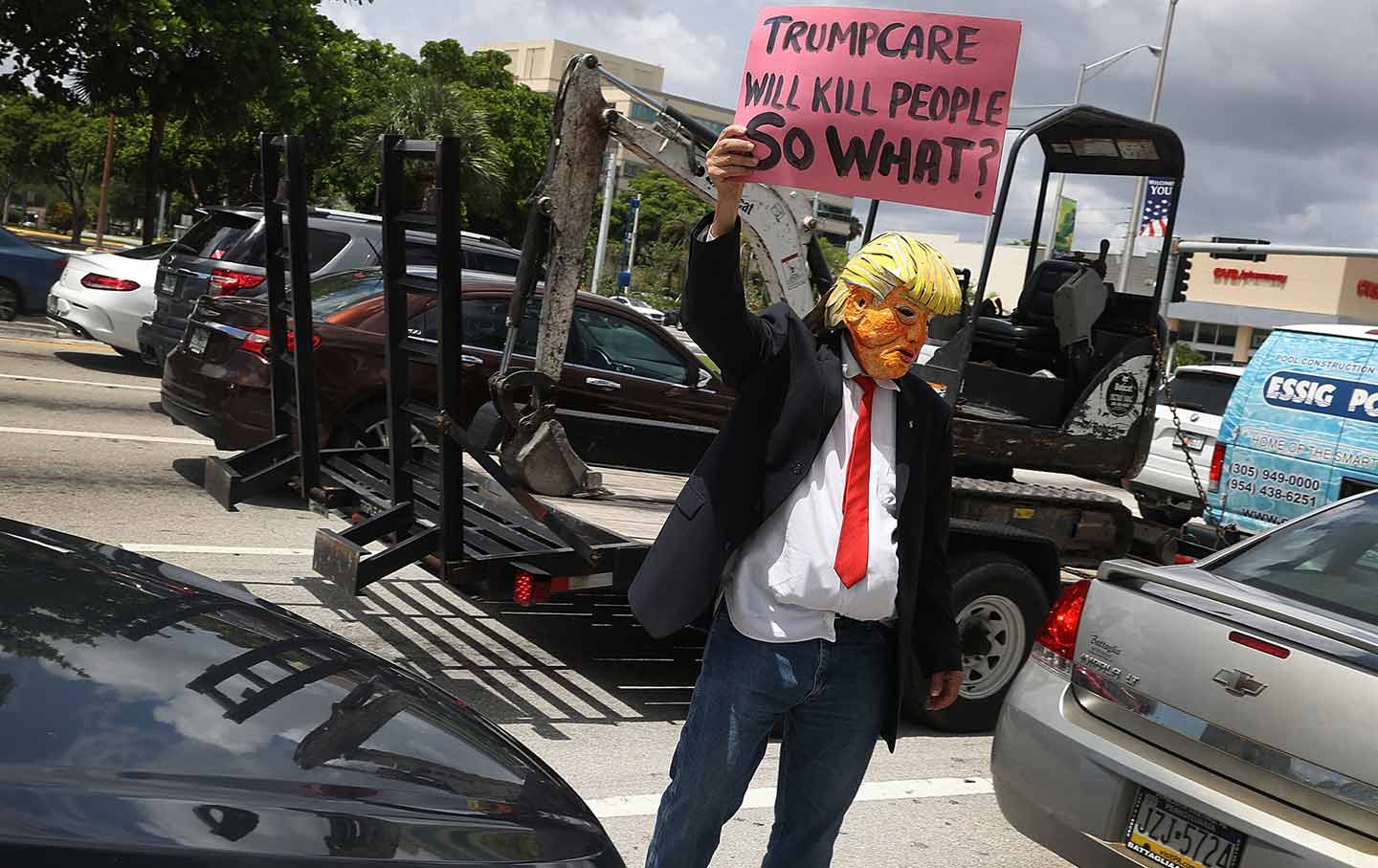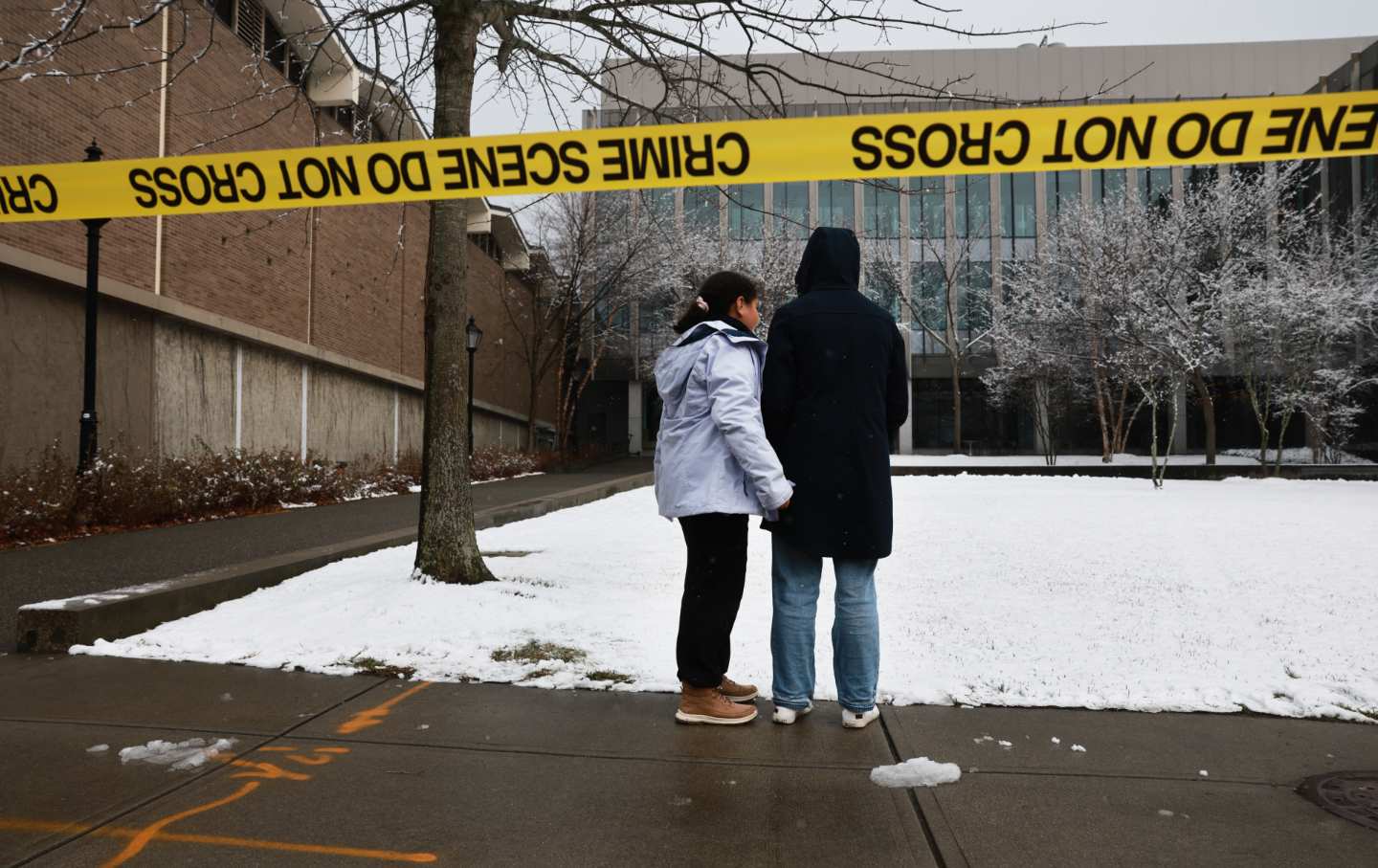The Battle to Protect Healthcare Will Define the Second Trump Era
Behind the language of “spending offsets” lies a stark reality: over $3 trillion in cuts that would reshape Americans’ access to healthcare.

Only eight days into his presidency, Donald Trump and his administration tried to end Medicaid for 22 million Americans. All 50 states were locked out of their Medicaid portals thanks to a memo from Trump’s team. It was their first attempt to steal your healthcare, but it won’t be their last.
Republicans have retaken the White House with a crystal-clear fiscal agenda: deep cuts to programs that you and your family rely on and tax cuts for Donald Trump and his billionaire kitchen cabinet.
Their “cost-cutting” target to finance government handouts to oligarchs? Healthcare, healthcare, healthcare.
Trump has already signed an executive order rescinding key aspects of former President Joe Biden’s work to strengthen Medicaid and the Affordable Care Act. Trump also overturned Biden’s “Lowering Prescription Drug Costs for Americans” order that would have—no surprise here—lowered drug costs for Americans.
It’s absolutely not just Trump. When asked about Trump’s move to kick millions of Americans off Medicaid, Republican Speaker Mike Johnson said, “I fully support it.” During his confirmation hearing, RFK Jr.—Trump’s pick to lead the agency that runs Medicaid—kept confusing the program with Medicare and refused to say that healthcare is a human right.
House Budget Committee chair Jodey Arrington is circulating what Republican leadership calls a “menu” of potential spending cuts. Behind the bureaucratic language of “spending offsets” lies a stark reality: over $3 trillion in proposed healthcare cuts that would reshape Americans’ access to healthcare as we know it, with impacts falling heaviest on children, seniors, and rural communities.
To understand what’s really at stake, we need to look past the talking points to see how these changes would play out in our communities. Consider Medicaid: Four in 10 American children rely on it for their healthcare. It covers 41 percent of all births in our nation. Perhaps most striking, five in every eight nursing home residents depend on Medicaid to fund their care.
The proposed changes would fundamentally alter this vital program. By implementing per-person spending caps and slashing federal support, Republican plans would force impossible choices onto state governments. States would face an inevitable triangle of pain: cut benefits, reduce the number of people who are covered, or raise in-state taxes. There’s no fourth option.
Rural America would bear a particularly heavy burden. The changes to Medicare in the Budget Committee’s plan would cut hospital payments in ways that would threaten the survival of already struggling rural hospitals. These facilities, often the only healthcare provider for miles, operate on razor-thin margins. When they close, they don’t just take healthcare with them—they take emergency services, jobs, and often the economic heart of their communities.
In our cities, safety-net hospitals that serve our most vulnerable populations would face a double blow. The plan cuts both their Medicare payments and support for uncompensated care—the costs they incur treating patients who can’t pay. These hospitals, already operating at the financial edge, would face stark choices about reducing services or closing departments.
Here’s the important thing for Democrats and all Americans to know: Republican politicians have carefully structured this plan to obscure their political responsibility. They don’t want you to know they are responsible.
When your local hospital reduces services or closes, hospital officials will be the ones making the announcement. When your state cuts Medicaid benefits or eligibility, your governor and state legislature will have to deliver the news. But make no mistake—these would be forced choices, the inevitable result of Republican policy decisions, because they control the federal government.
The real impact would cascade through our communities in ways that touch countless lives: the young family relying on Medicaid for their child’s asthma medication, the rural senior who would have to drive an extra hour for emergency care after their local hospital closes, the nursing home resident whose family would suddenly face impossible choices about care.
That’s why this fight matters. Groups like American Bridge 21st Century and others must ensure that Americans understand the true stakes—that their representatives cannot hide behind complex funding formulas or shift blame to state governments. We must stay focused on the reality that funding tax cuts for the wealthy by cutting healthcare for working families is a choice Republicans are actively making to appease the billionaire class, not an inevitability.
Popular
“swipe left below to view more authors”Swipe →As we enter this new administration, Americans should ask themselves: Who is being asked to sacrifice, and who is lining their pockets with gold? Who is cutting their medication in half to save money, and who is flush with Big Pharma profits? Who is sitting at the table, and who is on the menu?
Disobey authoritarians, support The Nation
Over the past year you’ve read Nation writers like Elie Mystal, Kaveh Akbar, John Nichols, Joan Walsh, Bryce Covert, Dave Zirin, Jeet Heer, Michael T. Klare, Katha Pollitt, Amy Littlefield, Gregg Gonsalves, and Sasha Abramsky take on the Trump family’s corruption, set the record straight about Robert F. Kennedy Jr.’s catastrophic Make America Healthy Again movement, survey the fallout and human cost of the DOGE wrecking ball, anticipate the Supreme Court’s dangerous antidemocratic rulings, and amplify successful tactics of resistance on the streets and in Congress.
We publish these stories because when members of our communities are being abducted, household debt is climbing, and AI data centers are causing water and electricity shortages, we have a duty as journalists to do all we can to inform the public.
In 2026, our aim is to do more than ever before—but we need your support to make that happen.
Through December 31, a generous donor will match all donations up to $75,000. That means that your contribution will be doubled, dollar for dollar. If we hit the full match, we’ll be starting 2026 with $150,000 to invest in the stories that impact real people’s lives—the kinds of stories that billionaire-owned, corporate-backed outlets aren’t covering.
With your support, our team will publish major stories that the president and his allies won’t want you to read. We’ll cover the emerging military-tech industrial complex and matters of war, peace, and surveillance, as well as the affordability crisis, hunger, housing, healthcare, the environment, attacks on reproductive rights, and much more. At the same time, we’ll imagine alternatives to Trumpian rule and uplift efforts to create a better world, here and now.
While your gift has twice the impact, I’m asking you to support The Nation with a donation today. You’ll empower the journalists, editors, and fact-checkers best equipped to hold this authoritarian administration to account.
I hope you won’t miss this moment—donate to The Nation today.
Onward,
Katrina vanden Heuvel
Editor and publisher, The Nation
More from The Nation

In America, Mass Shooting Survivors Can Never Know Peace In America, Mass Shooting Survivors Can Never Know Peace
A growing number of US residents have lived through more than one massacre.

What the Noam Chomsky–Jeffrey Epstein E-mails Tell Us What the Noam Chomsky–Jeffrey Epstein E-mails Tell Us
Chomsky has often suffered fools, knaves, and criminals too lightly. Epstein was one of them. But that doesn’t mean Chomsky was part of the “Epstein class.”

Have We Normalized Nuclear War? Have We Normalized Nuclear War?
If anything, the widespread lack of comprehension (and so protest) is one big reason nuclear war remains so chillingly possible.

The Supreme Court v. My Mother The Supreme Court v. My Mother
After my mother escaped the Holocaust, she broke the law to save her family. Her immigration story is more pertinent today than ever before.

Keeping the Police Out of Pregnancy Care Keeping the Police Out of Pregnancy Care
We must be vigilant in keeping law enforcement out of exam rooms.

White Farmers Are Getting a Taste of Their Own Medicine White Farmers Are Getting a Taste of Their Own Medicine
Trump’s tariffs and immigration raids are driving the latest farm crisis. White farmers have stood by him year after year—and still do.


